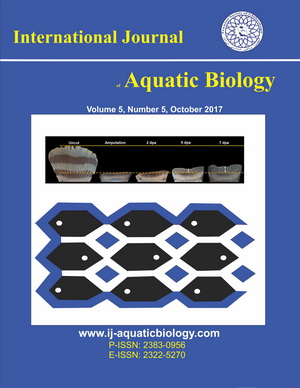Application of machine learning in predicting sources of water pollution in the Euphrates and Tigris Rivers in Iraq
Downloads
New evaluation and control methods are required to address the ecological, economic, and public health concerns raised by the contamination of the rivers Tigris and Euphrates. To minimize negative effects on ecosystems, our research built and implemented a machine learning framework to track down and foresee potential water contamination hotspots. To examine the causes of pollution and its consequences on aquatic ecosystems, researchers combined data from multiple sources, such as aerial photographs, field surveys, and official government documents. Predictive models encompass significant attributes such as pesticides, mineral composition, suspended particulates, diversity of macroinvertebrates, and habitat quality. Feature selection techniques, including LASSO regression and recursive feature elimination, ensured dependable model construction. Four machine learning algorithms of MCP, K-nearest neighbors, decision tree, and multi-layer perceptron were employed for pollution source recognition and impact prediction. The models correctly identified significant pollution sources, including untreated sewage, agricultural runoff, and industrial discharges. The concentration and distribution patterns of pollutants were elucidated by clustering and regression techniques. The results indicated reduced biodiversity, habitat degradation, and toxic algal blooms, as well as identified significant pollution areas. This research indicates that machine learning can transform environmental monitoring and water resource management. The study's practical findings, which integrate ecological and computational methodologies, can assist policymakers and water resource managers.
Downloads
Agibayeva A., Khalikhan R., Guney M., Karaca F., Torezhan A., Avcu E. (2022). An air quality modeling and disability-adjusted life years (DALY) risk assessment case study: Comparing statistical and machine learning approaches for PM2. 5 Forecasting. Sustainability, 14(24): 16641.
Ahram A.I. (2021). Human ecology of the marshes. In Southern Iraq's Marshes: Their Environment and Conservation. Springer International Publishing. pp: 55-76.
Al-Abadi A.M., Hassan A.A., Al-Moosawi N.M., Handhal A.M., Alzahrani H., Jabbar F.K., Anderson N.L. (2024). Drought susceptibility mapping in Iraq using GRACE/GRACE-FO, GLDAS, and machine learning algorithms. Physics and Chemistry of the Earth, Parts A/B/C, 134: 103583.
Al-Ansari N. (2021a). Water resources of Iraq. Journal of Earth Sciences and Geotechnical Engineering, 11(2): 15-34.
Al-Ansari N., Saleh S., Abdullah T., Abed S.A. (2021b). Quality of surface water and groundwater in Iraq. Earth Sciences and Geotechnical Engineering, 11(2): 161-199.
Al-Maliki L.A., Farhan S.L., Jasim I.A., Al-Mamoori S.K., Al-Ansari N. (2021). Perceptions about water pollution among university students: A case study from Iraq. Cogent Engineering, 8(1): 1895473.Al-Saadi N., Sadkhan K.A.M. (2021). Water resources decrease of river Euphrates and its impacts on the environment in Iraq. International Journal of Ecology and Environmental Sciences, 33-55.
Altahaan Z., Dobslaw D. (2024). Assessment of the impact of war on concentrations of pollutants and heavy metals and their seasonal variations in water and sediments of the Tigris River in Mosul/Iraq. Environments, 11(6): 66.
Al-Yasiri A.J. (2021). Iraq's post-2003 environmental pollution: Issues and solutions. Akkad Journal of Contemporary Economic Studies, 1(1): 1-16.
Anderson D.M., Glibert P.M., Burkholder J.M. (2002). Harmful algal blooms and eutrophication: nutrient sources, composition, and consequences. Estuaries, 25(4): 704-726.
APHA (American Public Health Association), (2017). Standard methods for the examination of water and wastewater. American Public Health Association.
Aziz Z.S., Jazaa S.H., Dageem H.N., Banoon S.R., Balboul B.A., Abdelzaher M.A. (2024). Bacterial biodegradation of oil-contaminated soil for pollutant abatement contributing to achieve sustainable development goals: A comprehensive review. Results in Engineering, 102083.
Barbour M.T., Gerritsen J., Snyder B.D., Stribling J.B. (1999). Rapid bioassessment protocols for use in streams and wadeable rivers: periphyton, benthic macroinvertebrates and fish. US Environmental Protection Agency.
Benouis K., Khane Y., Ahmed T., Albukhaty S., Banoon S.R. (2022). Valorization of diatomaceous earth as a sustainable eco-coagulant for wastewater treatment: optimization by response surface methodology. Egyptian Journal of Chemistry, 65(9): 777-788.
Bryan G.W., Langston W.J. (1992). Bioavailability, accumulation and effects of metals in aquatic systems. In: Metal Ecotoxicology: Concepts and Applications. Lewis Publishers, Boca Raton, FL. pp: 35-70.
Chen T., Wang T., Xue L., Brasseur G. (2024). Heatwave exacerbates air pollution in China through intertwined climate–energy–environment interactions. Science Bulletin.
Chorus I., Bartram J. (1999). Toxic cyanobacteria in water: a guide to their public health consequences, monitoring and management. World Health Organization.
Cortes C., Vapnik V. (1995). Support-vector networks. Machine learning, 20(3): 273-297.
Cover T., Hart P. (1967). Nearest neighbor pattern classification. IEEE Transactions on Information Theory, 13(1): 21-27.
Elbeltagi A., Mohamed E.S., Masoud M., Islam A.R.M.T. (2021). Groundwater quality assessment using machine learning algorithms and GIS in the north Sinai, Egypt. Journal of Hydrology, 597: 126190.
Evans M.I. (1994). Important bird areas in the Middle East. BirdLife International. 410 p.
Fadhil A.A., Swaid S.Y., Mohammed S.J., Al-Abboodi A. (2024). Impact of salinity on tomato seedling development: A comparative study of germination and growth dynamics in different cultivars. Journal of Chemical Health Risks, 14(1): 183-190.
FAO (Food and Agriculture Organization of the United Nations). (2016). Water for Sustainable Food and Agriculture. A report by the FAO.
Fawcett T. (2006). An introduction to ROC analysis. Pattern Recognition Letters, 27(8): 861-874.
Gilliom R.J., Barbash J.E., Crawford C.G., Hamilton P.A., Martin J.D., Nakagaki N., Wolock D.M. (2006). The quality of our nation’s waters: pesticides in the nation’s streams and ground water. US Geological Survey.
Guyon I., Weston J., Barnhill S., Vapnik V. (2002). Gene selection for cancer classification using support vector machines. Machine Learning, 46: 389-422.
Hamza A.R., Ali H.A.A., Jabbar H.W. (2024). Environmental pollution and its impact on economic growth in Iraq (an applied study on the reality of the Iraqi economy). International Journal of Business and Management Sciences, 4(05): 91-106.
Hassan S.A.H., Al-Furiji H., Rashid M.K., Hussein Z.A., Ambudkar B. (2024). Trending Algorithm on Twitter through 2023. Data and Metadata, 3: 384-384.
Hassan S.A., Almaliki M.N., Hussein Z.A., Albehadili H.M., Banoon S.R., Al-Abboodi A., Al-Saady M. (2023). Development of nanotechnology by artificial intelligence: a comprehensive review. Journal of Nanostructures, 13(4): 915-932.
Iraq Ministry of Planning. (2020). Annual statistical abstract.
Jensen J.R. (2015). Remote sensing of the environment: an earth resource perspective. Pearson Education, Inc.
Jordan M.I., Mitchell T.M. (2015). Machine learning: Trends, perspectives, and prospects. Science, 349(6245): 255-260.
Karr J.R. (1981). Assessment of biotic integrity using fish communities. Fisheries, 6(6): 21-27.
Kirk J.T.O. (1994). Light and photosynthesis in aquatic ecosystems. Cambridge University Press. 528 p.
Lorenz F., Erickson E.J. (2023). Strategic water: Iraq and security planning in the Euphrates-Tigris Basin. dtic.mil.
Madhi A.K., Azeez N.M. (2024). A review of water quality and pollution assessment of the Euphrates River. Science.
Mahmud S.F. (2021). Opportunities and challenges of sustainable agricultural development in Iraq. International Journal of Social Relevance and Concern, 9(1): 12-24
Moriasi D.N., Arnold J.G., Van Liew M.W., Bingner R.L., Harmel R.D., Veith T.L. (2007). Model evaluation guidelines for systematic quantification of accuracy in watershed simulations. Transactions of the ASABE, 50(3): 885-900.
Mueller A., Detges A., Pohl B., Reuter M.H., Rochowski L., Volkholz J., Woertz E. (2021). Climate change, water and future cooperation and development in the Euphrates-Tigris basin. Research Gate / Geoscience/ Report, 38-53.
Mullen C.J., Grineski S.E., Collins T.W., Flores A.B. (2024). Air quality sensors and distributional environmental justice: a case study of Salt Lake County, Utah. Environmental Sociology, 10(2): 179-191.
Nazari A., Karbasi M., Abdollahi H. (2021). A review on application of machine learning in water resources engineering. International Journal of Environmental Science and Technology, 18(5): 1191-1206.
Oleiwi A.S., Al-Dabbas M. (2022). Assessment of contamination along the Tigris River from Tharthar-Tigris canal to Azizziyah, middle of Iraq. Water, 14(23): 3862.
Olson K.R., Speidel D.R. (2024). Tigris, Euphrates, and Shatt Al-Arab River System: Historic and Modern Attempts to Manage and Restore Iraq's Lifeline. Open Journal of Soil Science, 14(1): 1.
Plafkin J.L., Barbour M.T., Porter K.D., Gross S.K., Hughes R.M. (1989). Rapid bioassessment protocols for use in streams and rivers: benthic macroinvertebrates and fish. US Environmental Protection Agency.
Pongpiachan S., Hirisajja J., Aekakkararungroj A., Gupta P., Rungsiyanon S., Choochuay C., Poshyachinda S. (2024). Impacts of Meteorological Parameters on COVID-19 Transmission Trends in the Central Part of Thailand. Aerosol Science and Engineering, 1-14.
Proshad R., Islam S., Tusher T.R., Zhang D., Khadka, S., Gao J., Kundu S. (2021). Appraisal of heavy metal toxicity in surface water with human health risk by a novel approach: a study on an urban river in vicinity to industrial areas of Bangladesh. Toxin Reviews, 40(4): 803-819.
Rahi K.A., Halihan T. (2021). Surface water salinity of the Euphrates, Tigris, and Shatt al-Arab Rivers. In: Tigris and Euphrates Rivers: Their Environment from Headwaters to Mouth. Springer, Cham. pp: 309-336.
Rash A., Mustafa Y., Hamad R. (2023). Quantitative assessment of land use/land cover changes in a developing region using machine learning algorithms: A case study in the Kurdistan Region, Iraq. Heliyon, 9(11).
Reynolds J.B. (1996). Electrofishing. American Fisheries Society.
Rumelhart D.E., Hinton G.E., Williams R.J. (1986). Learning representations by back-propagating errors. Nature, 323(6088): 533-536.
Copyright (c) 2024 International Journal of Aquatic Biology

This work is licensed under a Creative Commons Attribution 4.0 International License.








